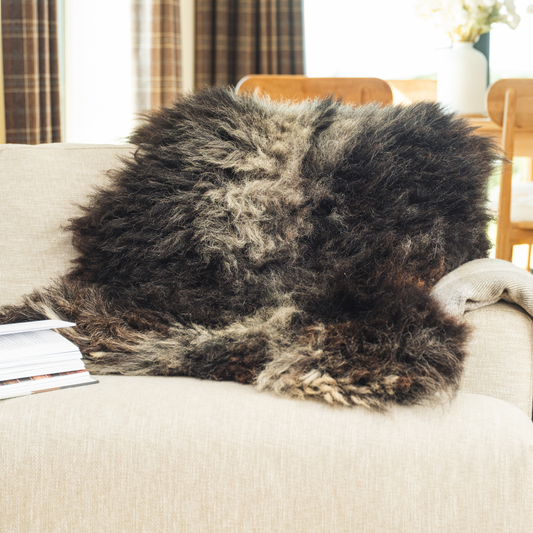We get a lot of questions about where our sheepskins come from, how they come to us, etc. This is the first part of the process and is critical in achieving a high quality end result.
All our sheepskins are a by-product of the meat industry. Farmers usually send their lambs to the abattoir from September onwards, and we choose from lambskins produced between September and January. This is when we get the best quality wool.
Our skin merchant Bill, from Munro’s in Dingwall, has decades of experience in choosing skins (a skill in itself) and he has been working with us for many years. He knows exactly what we are looking for: interesting skins and colourings, the right shapes, a good length of wool but not too long.
Sheepskins from Dingwall will come from all over the Highlands and Islands and will include most of the well-known breeds we find across Scotland: Blackface white, Hebridean browns, Herdwicks, Jacobs, etc.
The best sheepskins usually come from lambs that go for meat aged 9 or 10 months. They have had a chance to grow their wool but it hasn’t been shorn yet (after shearing the wool grows back quite coarse).
The sheep usually make it to Dingwall before January as, after winter, the wool quality is not as good and the wool is too long. The condition of the sheep affects the condition of the fleece: if they are ill, if their diet is wanting, the nutrients won’t go into the wool but into keeping the sheep alive and well.
The skins are usually salted less than an hour after removal. Salt draws moisture out very effectively. The key here is to prevent moisture going into the skin, as this may to lead to bacteria and rot.
The first thing to break down would be the hair follicles which are key to our work. Usually the skin is laid out over a pallet and salt is applied generously. The next day, the skin is shaken down and more salt applied. This extracts a lot of moisture from the skin.
We shake them down and add even more salt once they have been transported to our own storeroom in Waternish. The salt used is very similar to table salt, just to a little coarser, so that it goes into all the nooks and crannies of the skin. We spend more time looking after the skin than we do the wool, as it is essential to the fleece’s final condition.
We can store our salted skins for up to 18 months but we normally use them well before that. When we’re ready, the skins will come down to the tannery for the next stage in the process.
NEXT WEEK: We'll talk about the tannery and our tanners, new and old, and highlight some of the skills handed down through generations of craftsmen and women.


